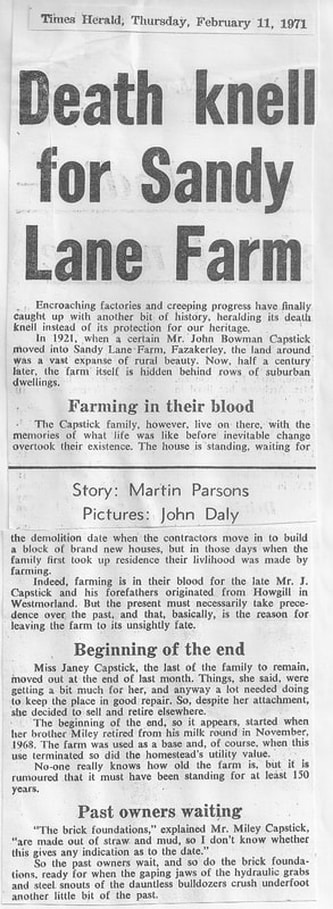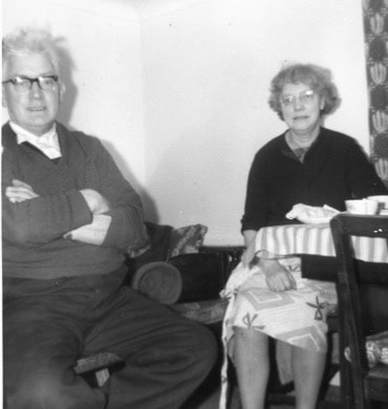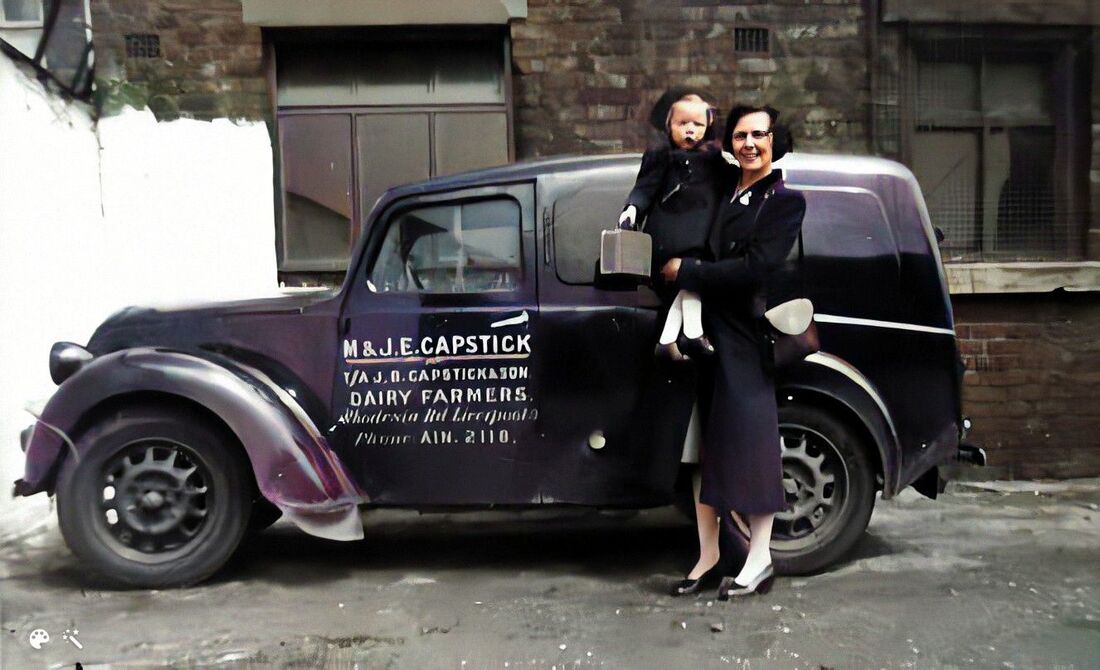
I am most grateful to a mystery person who attended one of my talks and handed me a file of information. If that person is you, please do get in touch so that I can thank you properly!
The file contained various papers, including a newspaper cutting from 1971 with the headline: ’Death knell for Sandy Lane Farm’. The prompt for the article was the imminent demolition of the former farmhouse and its recent vacation by Miss Elizabeth Jane Capstick — the last member of the Capstick family who had lived and worked at Sandy Lane Farm, Fazakerley.
Also included in the file were notes of an interview with Miss Capstick. The interview took place in 1991, when she was 84 years old. Her recollections of growing up at Sandy Lane Farm provide a fascinating glimpse of what it was like keeping cows on land that was eventually to be engulfed by the inexorable expansion of the city.
Originally, the property consisted of two farmhouses — known as The Calibar — surrounded by fields and connected to Sandy Lane by a farm track – hence the name, Sandy Lane Farm. However, later, when the Corporation acquired these fields for development, the property became disconnected from Sandy Lane. Its new address became Rhodesia Road, but the property retained the name and was still known as ‘Sandy Lane Farm’.
Coincidentally, I was subsequently contacted by Ann Osborne, who sent me a lovely family photo of herself as a child, taken outside the dairy in Rhodesia Road, owned by her great-aunt: the same Miss Elizabeth Jane Capstick mentioned above, she was known as ‘Janey’.
Janey’s father was John Bowman Capstick who came from Howgill, near Sedbergh; he was one of ten children. In April 1900 he married Annie Greenwood, from Cautley. By the time of the 1901 census they were living at 10 LEDWARD STREET in Liverpool and John’s occupation was given as ‘Cowkeeper’ (Janey was born there, in 1907). However, ten years later they were living at 16 Woodland Road, Cherry Lane, Walton, and John’s occupation was given as Farm Labourer – he worked on a farm in Wavertree, near Picton Clock. It wasn’t until 1921 that they relocated to SANDY LANE FARM. Janey was 15 years old at the time; she was one of seven children: Margaret (b. 1901), Joseph (b. 1902), Miles (b. 1904), Janey (b. 1907), Annie (b. 1910), John (b. 1913) and Clara (b. 1915).
The file contained various papers, including a newspaper cutting from 1971 with the headline: ’Death knell for Sandy Lane Farm’. The prompt for the article was the imminent demolition of the former farmhouse and its recent vacation by Miss Elizabeth Jane Capstick — the last member of the Capstick family who had lived and worked at Sandy Lane Farm, Fazakerley.
Also included in the file were notes of an interview with Miss Capstick. The interview took place in 1991, when she was 84 years old. Her recollections of growing up at Sandy Lane Farm provide a fascinating glimpse of what it was like keeping cows on land that was eventually to be engulfed by the inexorable expansion of the city.
Originally, the property consisted of two farmhouses — known as The Calibar — surrounded by fields and connected to Sandy Lane by a farm track – hence the name, Sandy Lane Farm. However, later, when the Corporation acquired these fields for development, the property became disconnected from Sandy Lane. Its new address became Rhodesia Road, but the property retained the name and was still known as ‘Sandy Lane Farm’.
Coincidentally, I was subsequently contacted by Ann Osborne, who sent me a lovely family photo of herself as a child, taken outside the dairy in Rhodesia Road, owned by her great-aunt: the same Miss Elizabeth Jane Capstick mentioned above, she was known as ‘Janey’.
Janey’s father was John Bowman Capstick who came from Howgill, near Sedbergh; he was one of ten children. In April 1900 he married Annie Greenwood, from Cautley. By the time of the 1901 census they were living at 10 LEDWARD STREET in Liverpool and John’s occupation was given as ‘Cowkeeper’ (Janey was born there, in 1907). However, ten years later they were living at 16 Woodland Road, Cherry Lane, Walton, and John’s occupation was given as Farm Labourer – he worked on a farm in Wavertree, near Picton Clock. It wasn’t until 1921 that they relocated to SANDY LANE FARM. Janey was 15 years old at the time; she was one of seven children: Margaret (b. 1901), Joseph (b. 1902), Miles (b. 1904), Janey (b. 1907), Annie (b. 1910), John (b. 1913) and Clara (b. 1915).
 Sandy Lane Farm, Fazakerley.
Sandy Lane Farm, Fazakerley.
Initially, Mr Capstick rented the farm but sometime later he bought it outright. The farmhouse had a thatched roof and they used oil lamps, as there was no electric supply. First they grew potatoes, corn and hay, later they had 12-14 cows, pigs and poultry (selling the milk and eggs). Inspectors used to call to the farm to test the milk and check the cows over. Only licenced dairies were allowed to sell milk.
When they first moved in they used to walk to Kirkby — they had farmer friends there. The trams only ran to the Black Bull — later to Barlows Lane, then to Fazakerley. The fields opposite Kirkdale Cemetery also belonged to Mr Capstick. Eventually, the corporation would buy that land from him to build houses.
Janey's father would not allow the girls to work on the farm, but they could help in the house and sell eggs. She remembers on one occasion having posters made saying “Easter Special Offer” 1 dozen eggs for 10d. The boys worked on the land and milked the cows. A nephew of theirs could not drink cow’s milk. However, the vicar of Emmanuel Church, Mr Collins, kept goats at his home at 6 Higher Lane. Mr Capstick bought one of these goats and kept it so the child could drink goat’s milk.
When they first moved in they used to walk to Kirkby — they had farmer friends there. The trams only ran to the Black Bull — later to Barlows Lane, then to Fazakerley. The fields opposite Kirkdale Cemetery also belonged to Mr Capstick. Eventually, the corporation would buy that land from him to build houses.
Janey's father would not allow the girls to work on the farm, but they could help in the house and sell eggs. She remembers on one occasion having posters made saying “Easter Special Offer” 1 dozen eggs for 10d. The boys worked on the land and milked the cows. A nephew of theirs could not drink cow’s milk. However, the vicar of Emmanuel Church, Mr Collins, kept goats at his home at 6 Higher Lane. Mr Capstick bought one of these goats and kept it so the child could drink goat’s milk.
 Miley and Janey Capstick continued to run the family business.
© Ann Osborne 2017
Miley and Janey Capstick continued to run the family business.
© Ann Osborne 2017
When Janey was older she would go out on the milk round with her eldest brother, Joe, in the horse and trap. Joe would drop her off, together with the milk churns, by the police station in Higher Lane, returning later to collect them. She would deliver the milk on foot with a churn and ladle — using the ladle to fill customers’ jugs, or if customers were out, leaving a small can which then had to be collected later in the day. She remembered on one occasion going back to Higher Lane but all the churns had disappeared. The policeman had played a joke on her and taken them into the police station.
They had two horses, one for the trap and the other for the mowing machine and farm work. When the brothers used to take the farm produce to market they would cover the horse’s feet with sacks to muffle the sound on the cobbled streets. Joe and his younger brother Miles (Miley) won prizes for the horse at the Woolton Show and at the Christmas Show in Cazneau Street.
At one time, Joe worked at the Aintree racecourse. He used to help with the pigs and help build fences for The Grand National racing. If he or his work pals caught any loose horses, they were paid 10/- for each one. After their mother died, he took over the dairy at 4 Marlborough Road, Tuebrook , from where his line of the family would go on to be the last of the city’s cowkeepers. The youngest brother, John, was in the Park Police, where he rose to the rank of Inspector.
Miley continued to run the milk business with Janey. The business retained the original family trading name: J. B. Capstick & Son. Their horse and cart was replaced by a petrol-driven van for delivering the milk. Miley retired in November 1968, but it wasn’t until January 1971 that Janey moved out, when the property was due for demolition.
It seems the Capstick’s family business at Sandy Lane followed the same pattern as many of the other dairy businesses in the city. To begin with they were ‘farmers’, growing crops and raising animals for milk and meat. With the loss of land, they became ‘cowkeepers’, producing and selling their own milk. Ultimately, as the costs of production became prohibitive for a family business, they dispensed with keeping their own herd and bought-in ready-bottled/treated milk. The business then focussed on milk delivery – they became suburban ‘milkmen’.
They had two horses, one for the trap and the other for the mowing machine and farm work. When the brothers used to take the farm produce to market they would cover the horse’s feet with sacks to muffle the sound on the cobbled streets. Joe and his younger brother Miles (Miley) won prizes for the horse at the Woolton Show and at the Christmas Show in Cazneau Street.
At one time, Joe worked at the Aintree racecourse. He used to help with the pigs and help build fences for The Grand National racing. If he or his work pals caught any loose horses, they were paid 10/- for each one. After their mother died, he took over the dairy at 4 Marlborough Road, Tuebrook , from where his line of the family would go on to be the last of the city’s cowkeepers. The youngest brother, John, was in the Park Police, where he rose to the rank of Inspector.
Miley continued to run the milk business with Janey. The business retained the original family trading name: J. B. Capstick & Son. Their horse and cart was replaced by a petrol-driven van for delivering the milk. Miley retired in November 1968, but it wasn’t until January 1971 that Janey moved out, when the property was due for demolition.
It seems the Capstick’s family business at Sandy Lane followed the same pattern as many of the other dairy businesses in the city. To begin with they were ‘farmers’, growing crops and raising animals for milk and meat. With the loss of land, they became ‘cowkeepers’, producing and selling their own milk. Ultimately, as the costs of production became prohibitive for a family business, they dispensed with keeping their own herd and bought-in ready-bottled/treated milk. The business then focussed on milk delivery – they became suburban ‘milkmen’.
Miley's retirement was reported in the Liverpool Echo on Friday 15 November 1968:
AND THE CUSTOMERS CRY AS THE MILKMAN SAYS GOODBYE
A remarkable record of service came to an end in Fazakerley a few days ago. Mr Miles Capstick, the dairyman, who has delivered milk there for the past 47 years, made his last round and for many of his customers it was a time for tears.
"I cried myself,” said Mr Capstick, whose father Mr John Capstick, started the dairy in 1921. “I decided to give it up because of my health. I'm 64 and the doctors have been telling me to do so for some time."
With his sister, Miss Jane Capstick, he has run the dairy at Sandy Lane Farm, Rhodesia Road, since his father died in 1949. All his life he has been delivering milk. At the age of nine he used to make the rounds in Clubmoor when it was 2d pint. Every day he has got up at 3.30 a.m., without an alarm clock, and only three times has he gone sick or been away on holiday. He was a great favourite his 500 customers. The children used to call him Miley and he was often seen holding their hands and making them smile.
“I’ll miss the children," he told me. "I just love them." There have been great changes. Up until 1957 he used to keep a small herd of cows and when they first started, Sandy Lane Farm was in the country. “We had a horse float with milk cans and a gill measure up until 1940, then we bought a van."
His sister Jane, who is 61, has also decided to retire and so J. B. Capstick & Son will soon cease to exist. His last words to me were typical of this generous man: “Please thank all my customers – they’ve been so good to me.”
